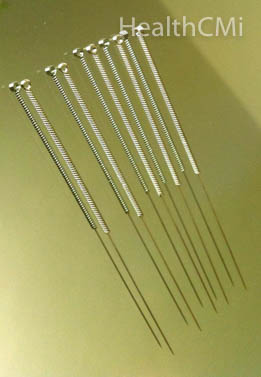Acupuncture regulates glucose levels in diabetics and improves the performance of metformin, an oral diabetes medication. Combining electroacupuncture with metformin improves glucose lowering performance and regulation of insulin secretion.  As a result of recent findings, researchers conclude that a combination of electroacupuncture with an insulin sensitiser may be a new treatment for type 2 diabetes.
As a result of recent findings, researchers conclude that a combination of electroacupuncture with an insulin sensitiser may be a new treatment for type 2 diabetes.
Liao et al. conducted a laboratory investigation on the effects of electroacupuncture and metformin on insulin resistant rats. The researchers comment that their investigation design is a humane model in that the rats need not be killed at the completion of the experiment. Blood samples, insulin assays, and immunohistochemical staining with western blot revealed important facts about how electroacupuncture achieves its therapeutic effects.
Electroacupuncture combined with metformin results in higher insulin levels than using only metformin. The researchers note that while metformin increases insulin sensitivity and inhibits gluconeogenesis, it “does not directly affect insulin secretion in the pancreas….” This indicates that the higher insulin levels were due to the addition of electroacupuncture treatments to acupuncture point ST36 (Zusanli).
An acupuncture plus metformin group was compared with a metformin only group. The researchers discovered that electroacupuncture increases the expression of MAPK insulin signalling factors. Mitogen-activated protein kinases (MAPK) regulate a variety of cell functions. The researchers note that higher MAPK levels in the electroacupuncture combined with metformin group were due, at least in part, to electroacupuncture induced muscle contractions.
Metformin mildly decreases plasma free fatty acid (FFA) levels. However, the addition of electroacupuncture significantly enhanced this effect. FFA increases are associated with insulin resistance and reduced insulin sensitivity. The researchers note that the results suggest that adding electroacupuncture (EA) therapy to metformin intake ameliorates “insulin resistance caused by FFAs.”
The researchers note, “In conclusion, we found that EA–metformin resulted in a better glucose-lowering effect, higher levels of insulin secretion, lower plasma FFA levels and higher levels of MAPK than metformin alone. The glucose-lowering effect and increased insulin sensitivity associated with EA–metformin administration is governed, at least in part, by its ability to stimulate the activation of GLUT4 via upregulation of MAPK expression.” 
The researchers noted several reasons for initiation of their investigation. Prior research by Lin et al. indicates that 2 Hz electroacupuncture at acupuncture point CV12 (Zhongwan) “reduces plasma glucose levels in diabetic rats.” Lee et al. discovered that electroacupuncture stimulates beta endorphin releases that increase insulin production in diabetic rats. Electroacupuncture at 15 Hz to acupoint ST36 induced glucose lowering responses through stimulation of cholinergic nerves and adrenal glands that subsequently stimulate the release of insulin signalling proteins. Electroacupuncture was also shown to enhance the expression of insulin receptor substrate 1 (IRS-1), an insulin signal protein that results in FFA decreases.
Liang et al. demonstrate that low frequency electroacupuncture improves insulin sensitivity in diabetic mice via activation of PGC-1alpha and SIRT1. PGC alpha is a master regulator of mitochondrial biogenesis. The protein deacetylase SIRT1 is a metabolic sensor that affects PGC alpha. Together, the two substances are involved in metabolic fitness. Lagouge et al. note, in their study of the benefits of resveratrol on mitochondrial function and prevention of metabolic disease, that SIRT1 is indicated “as a key regulator of energy and metabolic homeostasis.”
Liao et al. note that human clinical trials “should be undertaken to obtain clearer information about the role of EA in GLUT4 translocation as well as the long-term effects on the control of DM (diabetes melitis).” They note that the data indicates that combining electroacupuncture with an insulin sensitizing agent may be a new treatment strategy for type 2 diabetes mellitus.
References:
Liao, Hsien-Yin, Mao-Feng Sun, Jaung-Geng Lin, Shih-Liang Chang, and Yu-Chen Lee. "Electroacupuncture plus metformin lowers glucose levels and facilitates insulin sensitivity by activating MAPK in steroid-induced insulin-resistant rats." Acupuncture in Medicine (2015): acupmed-2014.
Lin JG, Chang SL, Cheng JT. Release of beta-endorphin from adrenal gland to lower plasma glucose by the electroacupuncture at Zhongwan acupoint in rats. Neurosci Lett 2002;326:17–20.
Lee YC, Li TM, Tzeng CY, et al. Electroacupuncture at the Zusanli (ST-36) acupoint induces a hypoglycemic effect by stimulating the cholinergic nerve in a rat model of streptozotocine-induced insulin-dependent diabetes mellitus.
Liang F, Chen R, Nakagawa A, et al. Low-frequency electroacupuncture improves insulin sensitivity in obese diabetic mice through activation of SIRT1/PGC-1alpha in skeletal muscle. Evid Based Complement Alternat Med 2011;2011:735297.
Lagouge, Marie, Carmen Argmann, Zachary Gerhart-Hines, Hamid Meziane, Carles Lerin, Frederic Daussin, Nadia Messadeq et al. "Resveratrol improves mitochondrial function and protects against metabolic disease by activating SIRT1 and PGC-1α." Cell 127, no. 6 (2006): 1109-1122.


